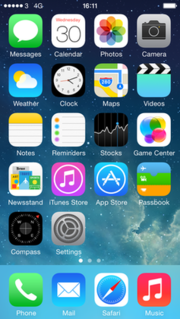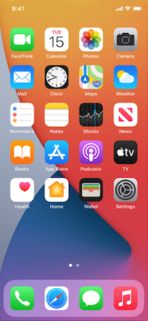
The iPod Touch is a line of iOS-based mobile devices designed and marketed by Apple Inc. with a touchscreen-controlled user interface. As with other iPod models, it can be used as a music player and a handheld gaming device, but it can also be used as a digital camera, a web browser and for messaging. It is similar in design to the iPhone, but it connects to the Internet only through Wi-Fi and does not use cellular network data, and so is not a smartphone.

iOS is a mobile operating system created and developed by Apple Inc. exclusively for its hardware. It is the operating system that powers many of the company's mobile devices, including the iPhone and iPod Touch; the term also included the versions running on iPads until the name iPadOS was introduced with version 13 in 2019. It is the world's second-most widely installed mobile operating system, after Android. It is the basis for three other operating systems made by Apple: iPadOS, tvOS, and watchOS. It is proprietary software, although some parts of it are open source under the Apple Public Source License and other licenses.
The version history of the mobile operating system iOS, developed by Apple Inc., began with the release of iPhone OS 1 for the original iPhone on June 29, 2007. Since its initial release, it has been used as the operating system for iPhone, iPad, iPod Touch, and HomePod. Continuous development since its initial release resulted in new major releases of the software, typically being announced at the annual Apple Worldwide Developers Conference and later released in September, coinciding with the release of new iPhone models. Starting with the 13.0 release, the operating system for iPad was split off as iPadOS. The latest version of iOS and iPadOS, 15.4, was released on March 14, 2022.

iTunes Remote is a software application developed by Apple Inc. for iOS devices that allows for remote control of Apple TV or iTunes library in an area with Wi-Fi connectivity using the proprietary Digital Audio Control Protocol (DACP). It is currently available as a free download from the App Store for iOS devices such as iPhone, iPod Touch, iPad, and Apple Watch.

AirDrop is a proprietary ad hoc service in Apple Inc.'s iOS and macOS operating systems, introduced in Mac OS X Lion and iOS 7, which can transfer files among supported Macintosh computers and iOS devices by means of close-range wireless communication. This communication takes place over Apple Wireless Direct Link 'Action Frames' and 'Data Frames' using generated link-local IPv6 addresses instead of the Wi-Fi chip's fixed MAC address.
Messages is an instant messaging software application developed by Apple Inc. for its macOS, iOS, iPadOS, and watchOS operating systems.

iOS 6 is the sixth major release of the iOS mobile operating system developed by Apple Inc, being the successor to iOS 5. It was announced at the company's Worldwide Developers Conference on June 11, 2012, and was released on September 19, 2012. It was succeeded by iOS 7 on September 18, 2013.

iOS 7 is the seventh major release of the iOS mobile operating system developed by Apple Inc., being the successor to iOS 6. It was announced at the company's Worldwide Developers Conference on June 10, 2013, and was released on September 18 of that year. It was succeeded by iOS 8 on September 17, 2014.

The iPhone 5C is a smartphone that was designed and marketed by Apple Inc. It is the seventh generation of the iPhone. The device was unveiled on September 10, 2013, and released on September 20, 2013, along with its higher-end counterpart, the iPhone 5S. The "c" in the iPhone 5c's name stands for Color.

The first-generation iPad Mini is a mini tablet computer designed, developed, and marketed by Apple Inc. It was announced on October 23, 2012, as the fourth major product in the iPad line and the first of the iPad Mini line, which features a reduced screen size of 7.9 inches (20 cm), in contrast to the standard 9.7 inches (25 cm). It features similar internal specifications to the iPad 2, including its display resolution.

iOS 8 is the eighth major release of the iOS mobile operating system developed by Apple Inc., being the successor to iOS 7. It was announced at the company's Worldwide Developers Conference on June 2, 2014, and was released on September 17, 2014. It was succeeded by iOS 9 on September 16, 2015.

iPhone OS 3 is the third major release of the iOS mobile operating system developed by Apple Inc., succeeding iPhone OS 2. It was announced on March 17, 2009, and was released on June 17, 2009. It was succeeded by iOS 4 on June 21, 2010,dropping the "iPhone OS" naming convention. iPhone OS 3 was the last version to use the "iPhone OS" naming convention.

iOS 9 is the ninth major release of the iOS mobile operating system developed by Apple Inc., being the successor to iOS 8. It was announced at the company's Worldwide Developers Conference on June 8, 2015, and was released on September 16, 2015. It was succeeded by iOS 10 on September 13, 2016.

iOS 10 is the tenth major release of the iOS mobile operating system developed by Apple Inc., being the successor to iOS 9. It was announced at the company's Worldwide Developers Conference on June 13, 2016, and was released on September 13, that year. It was succeeded by iOS 11 on September 19, 2017.

iOS 11 is the eleventh major release of the iOS mobile operating system developed by Apple Inc., being the successor to iOS 10. It was announced at the company's Worldwide Developers Conference on June 5, 2017, and released on September 19, 2017. It was succeeded by iOS 12 on September 17, 2018.

iOS 12 is the twelfth major release of the iOS mobile operating system developed by Apple Inc. Aesthetically similar to its predecessor, iOS 11, it focuses less on new functions than on performance, quality improvements and security updates. Announced at the company's Worldwide Developers Conference on June 4, 2018, iOS 12 was released to the public on September 17, 2018. It was succeeded for the iPhone and iPod Touch by iOS 13 on September 19, 2019 and for the iPad by iPadOS 13 on September 24, 2019. Security updates for iOS 12 continued for three years following the release of iOS 13.

iOS 13 is the thirteenth major release of the iOS mobile operating system developed by Apple Inc. for their iPhone, iPod Touch, and HomePod lines. The successor to iOS 12 on those devices, it was announced at the company's Worldwide Developers Conference (WWDC) on June 3, 2019, and released on September 19, 2019. It was succeeded by iOS 14, released on September 16, 2020.

iPadOS 13 is the first major release of the iPadOS mobile operating system developed by Apple Inc. for their iPad line of tablet computers. The successor to iOS 12 on those devices, it was announced at the company's 2019 Worldwide Developers Conference (WWDC) on June 3, 2019, as a derivation from iOS, with a greater emphasis on multitasking and tablet-centric features. It was released on September 24, 2019. It was succeeded by iPadOS 14, released on September 16, 2020.

iOS 14 is the fourteenth major release of the iOS mobile operating system developed by Apple Inc. for their iPhone and iPod Touch lines. Announced at the company's Worldwide Developers Conference on June 22, 2020 as the successor to iOS 13, it was released to the public on September 16, 2020. It was succeeded by iOS 15 on September 20, 2021.
The iOS mobile operating system developed by Apple Inc. has had a wide range of bugs and security issues discovered throughout its lifespan, ranging from security exploits discovered in most versions of the operating system related to the practice of jailbreaking, as well as bypassing the user's lock screen, to issues relating to battery drain, to crash bugs encountered when sending photos or certain Unicode characters via text messages sent through the Messages application, and general bugs and security issues later fixed in newer versions of the operating system.


















